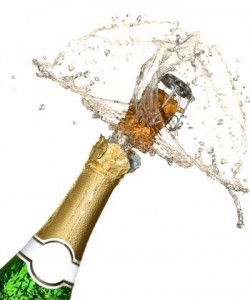
#220 – July 5, 2012
I hope everyone stateside had a great Fourth of July and managed to spend some of it outdoors despite the wretched heat wave currently baking the Northeast. As grilling season has officially started and is now in full swing, check out my Grillin’ & Chillin’ article on BBQing and wine for some tips on how to best enjoy wine throughout the suffocating summer Bar-B-Qing months. In honor of my newborn daughter’s first weekend home and in time-honored tradition, this past week I popped the cork on some excellent Champagne, the newly released Drappier Carte D’Or (reviewed below) that was the catalyst for this week’s newsletter on Champagne.
Despite its crisp refreshingness and near-perfect pairing with a vast quantity of foods, Champagne has unfortunately been pigeonholed as a celebratory beverage, providing a foaming festivity gushing at many a celebratory occasion. Centuries of celebrity quotes trumpeting Champagne as a wine to be consumed early and often including Winston Churchill’s “Champagne is the wine of civilization and the oil of government”, F. Scott Fitzgerald’s “Too much of anything is bad, but too much Champagne is just right” and Napoleon Bonaparte’s “I drink Champagne when I win, to celebrate and I drink Champagne when I lose, to console myself” (plagiarized and basterdized by Winston Churchill into “In victory we deserve it, in defeat we need it”) have not succeeded in convincing the wine-guzzling masses to incorporate it into their regular repertoire (if only Champagne would hire Chardonnay’s PR marketing guru). Despite the fact that I drink Champagne (and other sparkling wines) regularly (it is one of the best [and only] wines to be drinking in the morning), I realize I may be guilty of perpetuating its association with celebratory events by linking this week’s topic to the birth of Ariella. Therefore, I plan to spend the rest of this newsletter enlightening you to the wonders of Champagne in the hope that the next time you are looking for a refreshing and versatile wine, you will reach for the most luxurious of wines – Champagne.
While the British actually “invented” sparkling wine in the 17th century, they failed to make it their own, partly as a result of their inability to grow quality grapes during their inferior dark and dreary English summers. It wasn’t until 30 odd-years later that Champagne was born, after a French monk named Dom Pérignon fiddled with the process and helped create the luxurious wine by refining a number of the process (while an avid winemaker and oenophile, he wasn’t actually the “inventor” of Champagne, per se – for more on the history of Champagne try this link).
Despite prevalent usage around the globe as a descriptor for any wine with bubbles, legally Champagne may only refer sparkling wine grown in the chalky soil of France’s cool-climate Champagne Appellation D’origine Contrôlée (AOC), which yields grapes with considerable acidity contributing to Champagne’s food compatibility. In order to be labeled as Champagne, the wine must also be produced in accordance with a stringent set of rules comprising the traditional méthode champenoise (the traditional method of making Champagne described below). Located approximately 90 miles east of Paris, the region covers approximately 84,000 acres of prime wine-growing soil spread among 319 villages (Crus). Approximately 90% of this land is owned and farmed by nearly 15,000 independent growers with the remainder owned by the approximately 110 Champagne “Houses” and collectively yielding over 300 million bottles of Champagne a year. While the tradition of independent growers selling their crop to the houses continues for the most part, recent years have seen a proliferation of growers producing retaining all or part of their crop to produce, bottle and market Champagne under their own names with nearly 5,000 growers trying their hands these days at this process. These wines are commonly referred to as grower Champagne and are prized for their quality and uniqueness among oenophiles around the world. Unfortunately there are no kosher grower Champagne wines available today (and given the methodology of producing kosher French wine, I doubt there is any such grower Champagne in our near future either).
In addition to Champagne, many other quality sparkling wines from around the world (many of which I have previously reviewed) are produced in the méthode champenoise. However, in addition to trademarking the name “Champagne” and after substantial [and successful] lobbying, in 1994 Champagne growers obtained protection for the production method as well and non-Champagne wines made in this traditional method may now only be labeled as haven been made in the méthode traditionale (although unlike with Champagne, to date this is rarely enforced outside the European Union). This method incorporates a complex, intricate, expensive and multi-step process. Utilizing Champagne’s three primary grapes – Chardonnay, Pinot Noir and Pinot Meunier, the wine first undergoes a fermentation process similar to that of other quality still wines (typically in stainless steel tanks). Once this fermentation process has been completed, the still wine is bottled together with yeast and sugar (a syrup referred to as liqueur de triage) and then sealed, triggering a second fermentation in the bottle that yields the effervescence for which the wine is known. Once the secondary fermentation is completed and the wine has sufficiently “aged on its lees” (referred to as sur lie – see below), the bottle placed in a special rack, tilted downwards at a 45% angle and slowly rotated over time until the dead yeast cells (the “lees”) settle in the neck of the bottle (a process referred to as “riddling”). While some of the more prestigious Champagne wines are laboriously riddled by hand (over a period of 6-8 weeks, every few days each bottle requires a light tap and a slight turn), the majority of Champagne (and other sparkling wines made in the méthode traditionale) are riddled utilizing an automated process. Following the riddling process the wine is flash frozen, the lees removed (in a process known as disgorging) and the bottle is then topped up with a syrup known as liqueur d’expédition (to compensate for the total lack of residual sugar as a result of the secondary fermentation) in a process known as dosage (some Champagne houses claim a proprietary syrup with ingredients other than water and sugar), corked, sealed with a wire netting to prevent the corks escape and covered in the festive colored foil we see in the wine store. The amount of sugar in the added syrup will determine the level of the Champagne’s sweetness which is categorized based on dryness as follows: the sweetest level is doux, proceeding in order of increasing dryness to demi-sec (half-dry), sec (dry), extra sec (extra dry), brut (almost completely dry and the most common) and a small percentage of Champagne which is sold without any added sugar and categorized as extra brut, brut nature or brut zero.
Most Champagne is made from a blend of grapes produced in many different vintages (typically between 30-60 wines comprise every non-vintage Champagne!). While the majority of wine in any given non-vintage Champagne is derived from grapes of the current vintage year, a certain portion from past years utilized to ensure the aforementioned consistency (even a small amount of aged/vintage Champagne added to the non-vintage blend can add substantial depth, richness and complexity). This blending enables the winemaker to compensate for mediocre vintages and inconsistent climate. The most important marketing aspect for the Champagne houses (also the winemaker’s biggest challenge) is to ensure a consistent “House Blend” year after year and blending is likely the most important aspect of Champagne – the soul of Champagne. When preparing the blend, the winemaker needs to consider not what the wine tastes like right now but rather what the resulting wine will taste like after second fermentation and many years of aging on the lees. In exceptional vintage years a vintage is declared and the best wine from that year will be marketed as vintage Champagne requiring a minimum of three years bottle aging on its lees under the AOC rules (non-vintage Champagne requires a minimum of 1.5 years) and guaranteeing a substantially higher price. That said, most premium Champagne is aged around 6-8 years at least.
Besides vintage v. non-vintage Champagne, there are an additional number of different styles of Champagne including cuvee de prestige (typically the flagship Champagne of a Champagne house and usually the most well-known of its wines), Blanc de Noirs (which refers to a white Champagne made solely from “black” grapes, usually Pinot Noir and Pinot Meunier), Blanc de Blanc (which refers to a white wine made from only white grapes, usually 100% Chardonnay the best of which are sourced from the chalky slopes of the Côte des Blancs) and finally Rose Champagne. The years in which Rosé Champagne was largely disregarded as irrelevant from a serious wine perspective are long gone as nearly every major Champagne house worth its salt is producing at least one Rosé version. Produced by a different method than still Rosé, most Rosé Champagne is made by adding around 15% of still red wine to the otherwise white wine. Marketed as even more romantic and sexier than “regular” Champagne and coupled with a [controlled] scarcity, the prices of Rosé Champagne usually exceed those of their white brethren. Unfortunately, only than the delightful added color your money yields very little extra in the form of added nuance or complexity with the white versions usually being better than their more expensive Rosé versions.
While opening a bottle of Champagne is always accompanied with some celebratory fanfare, if only as a result of the delightful popping cork, for true entertainment and flair nothing beats sabrage. Sabrage refers to the method of opening a Champagne bottle with a saber (check out some of the cool videos of sabering on YouTube). While seemingly dangerous and complicated, sabering merely requires sliding a saber with slight force along the bottle. Coupled with the increased pressure inside the bottle, the force of the saber hitting the lip of the Champagne bottle breaks the glass and separates the lip from the rest of the bottle. While a saber may be somewhat tough to come by, many slightly sharp or very thin objects will suffice – I have seen someone do it in person with an iPad.
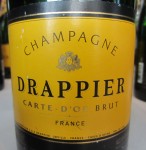 Drappier, Carte D’Or, Champagne, n.v.: A new true kosher Champagne imported by Royal wine, together with a Carte Blanc version (which I enjoyed less than this version). A very welcome addition to the kosher Champagne scene, especially since my all-time favorite Nicolas Feuillatte hasn’t been available for a while. Made from a blend of 80-90% Chardonnay, 5-15% Pinot Noir and 5% Pinot Meunier (all traditional Champagne grapes, if not in this exact combination), the wine has a delightful nose of citrus, toasty brioche, some green apples and stone fruits with hints of flinty minerals. Much of the same follows on the palate with more yeasty notes, and good tight and focused bubbles that keep the flavors going on your palate and this wine was actually enjoyable the next day (under a Champagne stopper). A bit more acidity wouldn’t have hurt but all in all, a delightful treat and worth trying.
Drappier, Carte D’Or, Champagne, n.v.: A new true kosher Champagne imported by Royal wine, together with a Carte Blanc version (which I enjoyed less than this version). A very welcome addition to the kosher Champagne scene, especially since my all-time favorite Nicolas Feuillatte hasn’t been available for a while. Made from a blend of 80-90% Chardonnay, 5-15% Pinot Noir and 5% Pinot Meunier (all traditional Champagne grapes, if not in this exact combination), the wine has a delightful nose of citrus, toasty brioche, some green apples and stone fruits with hints of flinty minerals. Much of the same follows on the palate with more yeasty notes, and good tight and focused bubbles that keep the flavors going on your palate and this wine was actually enjoyable the next day (under a Champagne stopper). A bit more acidity wouldn’t have hurt but all in all, a delightful treat and worth trying.
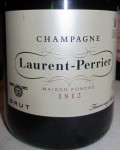 Laurent Perrier, Brut, n.v.: As with the Louis de Sacy wines reviewed below, I enjoy the brut version more than its sexier Rosé counterpart. Plenty of toasted brioche and warm nuts on the nose to go with a subdued array of green apples, citrus and pear notes. With a rich and complex palate so typical of true Champagne (and usually lacking in most other sparkling wines) and loaded with yeasty bread, hints of tropical fruit, zesty citrus notes all held together by tightly focused and tiny bubbles that continue to tantalize after the wine is good, this is a great bottle of wine and worthy of both special occasions and a random Monday evening with someone special.
Laurent Perrier, Brut, n.v.: As with the Louis de Sacy wines reviewed below, I enjoy the brut version more than its sexier Rosé counterpart. Plenty of toasted brioche and warm nuts on the nose to go with a subdued array of green apples, citrus and pear notes. With a rich and complex palate so typical of true Champagne (and usually lacking in most other sparkling wines) and loaded with yeasty bread, hints of tropical fruit, zesty citrus notes all held together by tightly focused and tiny bubbles that continue to tantalize after the wine is good, this is a great bottle of wine and worthy of both special occasions and a random Monday evening with someone special.
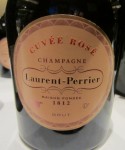 Laurent Perrier, Rosé Brut, n.v.: One of the only kosher Rosé Champagne wines made by a “real” Champagne house and a delicious treat (especially as it combines Rosé and Champagne – two of my favorite things). Less obligatory and more romantic (and expensive) than regular Champagne, Rosé Champagne has exploded in popularity over the last decade with more and more Champagne houses trying their hands at producing this lucrative wine even though the added romance and price seldom yield much in the way of additional nuance or complexity. This version is made from 100% Pinot Noir grapes and, as with most Rosé wines, is pretty light on the palate. Loaded with typical yeast, toasted bread and green apple flavors, these accompanied by lush strawberries, cherries and hints of slightly astringent citrus. This is a fun (albeit expensive fun) wine and a great accompaniment to any summer festivities. A real treat! I note that the quality of recent tasting has been somewhat sporadic with some bottles showing magnificently and others appearing tired.
Laurent Perrier, Rosé Brut, n.v.: One of the only kosher Rosé Champagne wines made by a “real” Champagne house and a delicious treat (especially as it combines Rosé and Champagne – two of my favorite things). Less obligatory and more romantic (and expensive) than regular Champagne, Rosé Champagne has exploded in popularity over the last decade with more and more Champagne houses trying their hands at producing this lucrative wine even though the added romance and price seldom yield much in the way of additional nuance or complexity. This version is made from 100% Pinot Noir grapes and, as with most Rosé wines, is pretty light on the palate. Loaded with typical yeast, toasted bread and green apple flavors, these accompanied by lush strawberries, cherries and hints of slightly astringent citrus. This is a fun (albeit expensive fun) wine and a great accompaniment to any summer festivities. A real treat! I note that the quality of recent tasting has been somewhat sporadic with some bottles showing magnificently and others appearing tired.
Louis de Sacy, Grand Cru, Brut n.v.: One of the things to be wary of when buying non-vintage Champagne is how long it has been sitting around since bottling (the bottles are stamped with a code indicating the bottling time but these are highly secret). I purchased this straight from the cellar of Sherry-Lehman thus guaranteeing myself a good result. The Champagne house of Louis de Sacy was established in the early 17th century. While not deemed one of the “Great Houses”, it is a great treat! Made from a traditional Champagne blend of Pinot Noir and Chardonnay (with some Pinot Meunier thrown in for good measure and character). Nice tangy berries including raspberries with plenty of lime and oranges to go with hazelnuts, some honey and yeasty bread all blend together for a delightful treat that went amazingly well with our celebratory dinner. Tons of tightly wound bubbles that lingered throughout the entire bottle also contributed to making this a wine to which I will return (especially now that my favorite Nicolas Feuillatte is no longer available.
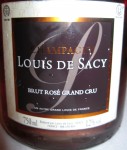 Louis de Sacy, Grand Cru, Rosé Brut n.v.: As with the Laurent Perrier above, the “regular” version is a better bet than the Rosé, assuming you are OK trading a bit of beauty for taste (and here I say to each their own or “Eilu V’eilu”). A traditional blend of 90% Pinot Noir and 10% Pinot Meunier yields a complex wine that is only slightly marred by a somewhat aggressive mousse (i.e. bubbles) that takes some getting used to. A lovely nose redolent of strawberries, red fruit, toasty bread, yeast and some pears. Much of the same of the slightly sweet palate with a hint of pleasing bitterness on the lingering finish.
Louis de Sacy, Grand Cru, Rosé Brut n.v.: As with the Laurent Perrier above, the “regular” version is a better bet than the Rosé, assuming you are OK trading a bit of beauty for taste (and here I say to each their own or “Eilu V’eilu”). A traditional blend of 90% Pinot Noir and 10% Pinot Meunier yields a complex wine that is only slightly marred by a somewhat aggressive mousse (i.e. bubbles) that takes some getting used to. A lovely nose redolent of strawberries, red fruit, toasty bread, yeast and some pears. Much of the same of the slightly sweet palate with a hint of pleasing bitterness on the lingering finish.
Nicolas Feuillatte, Brut, n.v.: Despite the fact that this wine is no longer available, it remains my all-time favorite kosher Champagne (which was a YH Best Buy to boot). I have included it here as I am finding it hard to let go of all the wonderful memories it has provided me with along the years (and hoping against hope that it will be resuscitated). A very dry wine with loads of lime, lemons and some grapefruit tastes along with hints of the traditional toasted white bread flavors with good bubbles that last forever.